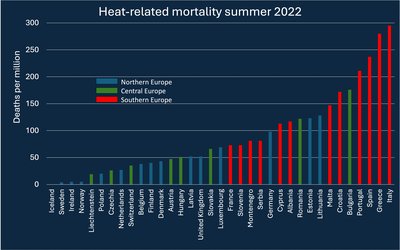Heat-related mortality: warmer regions benefit the most from limiting global warming
November 19, 2018

Photo: In Northern Europe, the reduction in cold-related mortality under global warming more or less equals the increase for heat. Net mortality in Southern Europe, however, may increase.
Limiting global warming to 1.5 - 2 °C, the targets of the Paris Agreement, will have an impact on heat-related mortality. Potential health benefits of the Paris Agreement have been assessed for 451 locations in 23 countries across the globe. Changes in heat and cold-related mortality were quantified for 1.5 and 2 °C, and for 3 and 4 °C. This was done under the assumption of no changes in demographic distribution and vulnerability.
From 1.5 to 2 °C: small impacts
The projected impacts of a global warming from 1.5 to 2 °C on mortality are relatively small. Overall, a rise in heat-related mortality is largely balanced by a projected decrease in cold-related mortality. In Southern Europe, projected heat-related mortality rises by about 0.7 - 0.8%. A smaller, not significant, decrease of cold-related mortality was calculated for cooler areas such as Northern Europe. For Central Europe, no substantial changes in mortality were calculated.
A further rise to 3 - 4°C: mortality increases
Heat-related mortality increase is no longer balanced by a decrease in cold-related mortality in large parts of the world when global warming rises to 3 or 4 °C. Central and southern regions of America, Europe, and East-Asia are projected to experience increases in heat-related mortality ranging between + 3.5 and + 8.9% for 4°C global warming. For cooler regions in Europe and Asia, the reduction in cold-related mortality more or less equals the increase for heat; these changes are less than 2%.
The projected net temperature-mortality, the combined effect of changes in heat and cold-related mortality, shows the largest increase for the warmest regions. For Southern Europe, for instance, this increase is + 4.4%. For Central Europe this increase is + 2.6%. For Europe and Asia, the overall pattern shows moderate decreases in excess mortality in the colder areas of the north, nearly null changes or small increases in the temperate central areas, and larger increases in warmer southern regions.
Tropical regions most vulnerable
Overall, the direct health consequences of climate change will be most visible in tropical regions, not only in terms of increases in average temperature and a higher likelihood of more intense extreme-heat events, but also more frequent extreme weather episodes (i.e., droughts and floods) and more severe indirect effects (i.e., changes in crop yields). In fact, these regions include the most populated areas worldwide and, in general, the most vulnerable to climate change, with a limited capacity for adaptation due to lack of infrastructural, financial, and technological resources.
Thus, populations living in warmer areas will benefit the most from limiting global warming to the targets of the Paris Agreement.
Vicedo-Cabrera et al., 2018. Climatic Change 150: 391-402.








